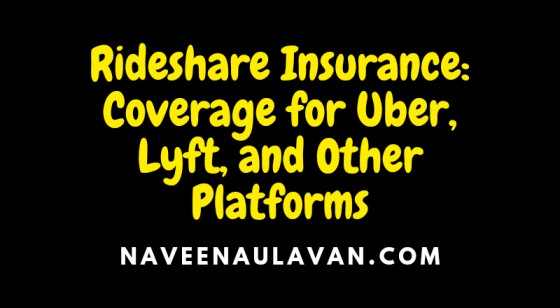The rise of ridesharing platforms like Uber and Lyft has revolutionized the way people commute and travel. These services offer convenience, affordability, and flexibility to both riders and drivers. However, one critical aspect often overlooked is insurance coverage. Standard personal auto insurance policies may not provide adequate protection for drivers working on rideshare platforms, leaving them vulnerable to financial risks. In this article, we will delve into the importance of rideshare insurance, the gaps in coverage that exist with personal auto policies, and how drivers can ensure they have the right coverage to protect themselves and their passengers.
1. The Rideshare Business Model
Ridesharing platforms operate under a unique business model where individuals use their personal vehicles to provide transportation services to passengers. Drivers sign up with these platforms and, through a mobile app, connect with passengers seeking rides. While this model offers flexibility for drivers, it also creates insurance challenges that are not adequately addressed by traditional personal auto insurance policies.
2. Understanding Personal Auto Insurance
Most private individuals carry personal auto insurance to protect themselves and their vehicles in case of accidents. However, standard personal auto policies have exclusions that come into play when a vehicle is used for commercial purposes, such as ridesharing. Personal auto insurance policies are designed with the assumption that the vehicle is being used for personal purposes, like commuting to work, running errands, or taking family trips. Once a vehicle is used for profit, such as transporting passengers for compensation, it no longer fits within the scope of coverage provided by typical personal auto policies.
3. The Coverage Gap
When a rideshare driver is logged into the rideshare app but has not yet accepted a ride request, there may be limited or no coverage from the rideshare company’s insurance policy. This period is known as the “coverage gap.” During this time, the driver’s personal auto insurance may also not provide coverage since the vehicle is being used for commercial purposes. If an accident occurs during this gap, the driver could be personally responsible for any damages, medical expenses, or liability claims.
4. Rideshare Insurance Explained
Rideshare insurance is a type of policy specifically designed to address the gaps in coverage that arise when a vehicle is used for ridesharing. It provides coverage for drivers during all phases of ridesharing, including when the app is on, waiting for a ride request, and while driving to pick up a passenger. Rideshare insurance offers comprehensive protection that extends beyond personal auto insurance, giving drivers peace of mind and financial security.
5. Coverage Options for Rideshare Drivers
Several insurance companies now offer specialized rideshare coverage as an add-on to personal auto policies. These policies typically cover three periods:
5.1 Period 1:
This period covers the time when the rideshare app is on, and the driver is waiting for a ride request. During this phase, the rideshare company’s insurance coverage may be limited, making rideshare insurance crucial.
5.2 Period 2:
Period 2 starts when the driver accepts a ride request and is en route to pick up the passenger. Rideshare insurance will bridge the gap left by the rideshare company’s limited coverage during this phase.
5.3 Period 3:
Period 3 includes the time from when the passenger enters the vehicle until they exit. At this stage, the rideshare company’s commercial insurance usually provides primary coverage. However, rideshare insurance can still act as a safety net if the rideshare company’s policy limits are exhausted.
6. Benefits of Rideshare Insurance
Having dedicated rideshare insurance offers numerous benefits to drivers:
6.1 Peace of Mind:
Rideshare insurance eliminates the uncertainty and financial risk associated with potential coverage gaps. Drivers can focus on their work without worrying about insufficient insurance protection.
6.2 Full Coverage:
With rideshare insurance, drivers have comprehensive coverage throughout their rideshare activities. They are protected in case of accidents, injuries to passengers, or damage to their vehicles.
6.3 Protection for Personal Assets:
Without proper coverage, an accident while ridesharing could lead to the depletion of personal assets to cover damages and legal liabilities. Rideshare insurance safeguards drivers’ personal finances.
6.4 Legal Compliance:
In many jurisdictions, rideshare drivers are required to carry commercial auto insurance. Rideshare insurance ensures drivers meet these legal requirements.
7. Costs of Rideshare Insurance
The cost of rideshare insurance can vary depending on several factors, including the driver’s location, driving history, the insurance provider, and the coverage limits selected. While rideshare insurance is an additional expense, the potential financial consequences of being uninsured or underinsured far outweigh the cost of the policy.
8. Choosing the Right Rideshare Insurance
When selecting rideshare insurance, drivers should consider the following:
8.1 Coverage Limits:
Ensure the policy provides adequate coverage for liability, property damage, and medical expenses. Higher coverage limits may offer better protection but could come at a higher premium.
8.2 Deductibles:
Understand the deductible amounts and choose one that aligns with your financial capability.
8.3 Additional Coverage:
Some policies may offer additional options, such as uninsured/underinsured motorist coverage, which can be valuable in hit-and-run accidents or when the at-fault driver lacks sufficient insurance.
8.4 Insurance Provider:
Research and compare different insurance companies to find one with a good reputation for customer service and claims handling.
9. Conclusion
Rideshare insurance is a critical investment for drivers working on platforms like Uber, Lyft, and others. It fills the gaps left by personal auto insurance and provides the necessary protection throughout all phases of ridesharing. With the increasing popularity of rideshare services and the potential risks involved, it is essential for drivers to understand their insurance needs and make informed decisions to safeguard themselves, their passengers, and their financial well-being. By choosing the right rideshare insurance policy, drivers can enjoy peace of mind and focus on providing safe and reliable transportation services to their passengers.
